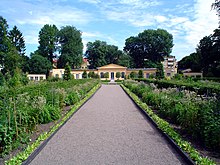Linnaean Garden
[1] The garden has been restored and is kept as an 18th-century botanical garden, according to the specifications of Carl Linnaeus, who started studying at Uppsala University in 1730 where he later became professor of botany and principal and is known for formalising the modern system of naming organisms, creating the modern binomial nomenclature,[2] and who owned the garden from 1741 and had it rearranged according to his own ideas, documented in his work Hortus Upsaliensis (1748).
[3] The garden was originally planned and planted by Olaus Rudbeck, professor of medicine, in 1655, and had about 1,800 different species in late 17th century, but was damaged in the 1702 Uppsala city fire.
In 1693, Rudbeck also built the house adjacent to the garden, nowadays known as the Linnaeus Museum (Linnémuséet), which was residence of Linnaeus from 1743, and from his death in 1778 to 1934 residence of employees at Uppsala University, the last of whom was musician Hugo Alfvén.
It was bought by the Swedish Linnaean Society in 1917 and restored according to the detailed description in the Hortus Upsaliensis.
The garden was later taken over by the university, while the Linnaeus Museum is still run by the Society.


